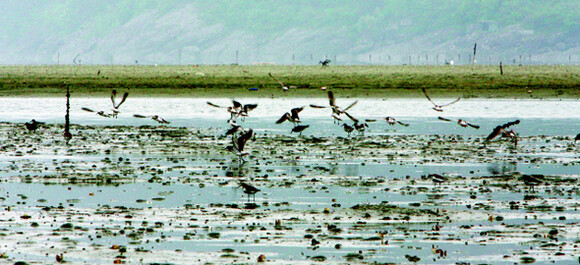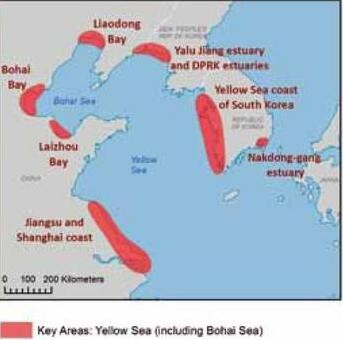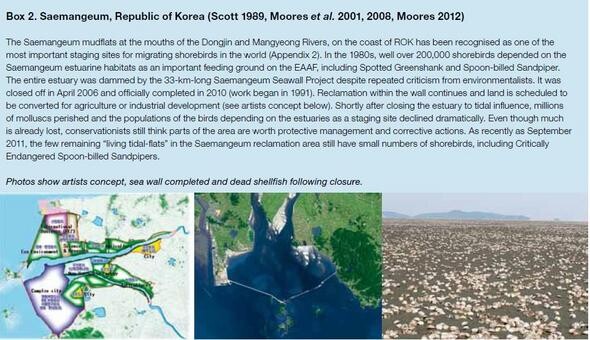hankyoreh
Links to other country sites 다른 나라 사이트 링크
Development endangering migratory Yellow Sea birds

By Kim Jeong-su, ecology reporter
According to a recent study, the most endangered migratory birds in the world live along mudflats in coastal areas of China and Korea along the Yellow Sea.
The report, done by the International Union for Conservation of Nature (IUCN) Asia Regional Office’s program on biodiversity preservation and the East Asian-Australasian Flyway (EAAF), found that water birds migrating through the EAAF are severely threatened, with the Yellow Sea area being the most problematic. Mudflats in this area are disappearing due to landfills, meaning that migrating birds no longer have places to stop and rest.

The report is titled “IUCN situation analysis on East and Southeast Asia Intertidal habitats, with particular reference to the Yellow Sea” and was presented on September 3 at the Seoul Press Center.
The IUCN analysis is based on research conducted by the Species Survival Commission (SSC), which is the largest body within the IUCN. The report, which is similar to the report being compiled by the Inter-governmental Panel on Climate Change (IPCC), will be used as the main working document for the IUCN conference to be held in Jeju Island from September 6. It is expected that environmental problems surrounding landfills in Saemanguem, on the southern coast of Korea, as well as other areas in Korea and China will be discussed in depth.
The report looked at 390 coastal sites used by migratory birds along the EAAF, which runs all the way between New Zealand and Siberia. 16 areas of concern were identified where there were 5-9% annual declines in waterbird species. These rates are among the highest of any ecological system on the planet, which is a matter of great concern since the EAAF is the busiest of all the world’s flyways.

The report identified six major flyway areas situated on the west coast of South Korea, the coast between Jiangsu and Shanghai, Bohai Sea, Laizhou Bay and the lower banks of the Yalu River in North Korea which are essential to the preservation of waterbirds like the sandpipers and plovers. Of the 54 species of these birds, 50 to 100% of 22 use this flyway. Also 70% of eight of the species use this area around the Yellow Sea as the middle point in their migration.
The government and companies working on land reclamation in the area have claimed until now that landfills did not pose such a big threat to the birds since they find alternative mudflats while flying through. However, according to the IUCN report, there is a direct correlation in the decline in the number of species with the deterioration in the number of mudflats where the birds rest.
One of the examples that the SSC uses is the Seamangeum development in Korea. It points out the change in the number of migratory birds since development started in the area. “Due to the development of Saemangeum, the number of migratory birds coming through here has decreased dramatically. These birds have been diverted by Saemangeum to the banks of the Kum River and Komso Bay,” the report said. The same applies to the birds observed in Australia.
The report also found that the land reclamation since the 1980’s in the six regions around the Yellow Sea has filled 35% of the mudflat areas on average and “this has been the central factor in the decline in biodiversity of the region”. The report warned that if this kind of development continues, the ecosystem will break down.
Scott Perkins, head of the IUCN Asia Office Biodiversity Preservation Program said, “I hope that this report will widely publicize the situation in this region and that the governments of the pertinent countries will work together in both policies and actions so that solutions can be provided.”


The IUCN report can be found at-
http://cmsdata.iucn.org/downloads/47_mackinnon_etal_2012_intertidal_report_web.pdf
Please direct questions or comments to [english@hani.co.kr]

Editorial・opinion
![[Editorial] Does Yoon think the Korean public is wrong? [Editorial] Does Yoon think the Korean public is wrong?](https://flexible.img.hani.co.kr/flexible/normal/500/300/imgdb/original/2024/0417/8517133419684774.jpg) [Editorial] Does Yoon think the Korean public is wrong?
[Editorial] Does Yoon think the Korean public is wrong?![[Editorial] As it bolsters its alliance with US, Japan must be accountable for past [Editorial] As it bolsters its alliance with US, Japan must be accountable for past](https://flexible.img.hani.co.kr/flexible/normal/500/300/imgdb/original/2024/0417/6817133413968321.jpg) [Editorial] As it bolsters its alliance with US, Japan must be accountable for past
[Editorial] As it bolsters its alliance with US, Japan must be accountable for past- [Guest essay] Amending the Constitution is Yoon’s key to leaving office in public’s good graces
- [Editorial] 10 years on, lessons of Sewol tragedy must never be forgotten
- [Column] A death blow to Korea’s prosecutor politics
- [Correspondent’s column] The US and the end of Japanese pacifism
- [Guest essay] How Korea turned its trainee doctors into monsters
- [Guest essay] As someone who helped forge Seoul-Moscow ties, their status today troubles me
- [Editorial] Koreans sent a loud and clear message to Yoon
- [Column] In Korea’s midterm elections, it’s time for accountability
Most viewed articles
- 1‘Right direction’: After judgment day from voters, Yoon shrugs off calls for change
- 2[Editorial] Does Yoon think the Korean public is wrong?
- 3[Editorial] As it bolsters its alliance with US, Japan must be accountable for past
- 4Japan officially says compensation of Korean forced laborers isn’t its responsibility
- 5Strong dollar isn’t all that’s pushing won exchange rate into to 1,400 range
- 6[Guest essay] How Korea turned its trainee doctors into monsters
- 7[Guest essay] Amending the Constitution is Yoon’s key to leaving office in public’s good graces
- 8Where Sewol sank 10 years ago, a sea of tears as parents mourn lost children
- 9Umbrella with holes: New NK missiles prove Seoul’s defense system to be faulty at best
- 10‘National emergency’: Why Korean voters handed 192 seats to opposition parties